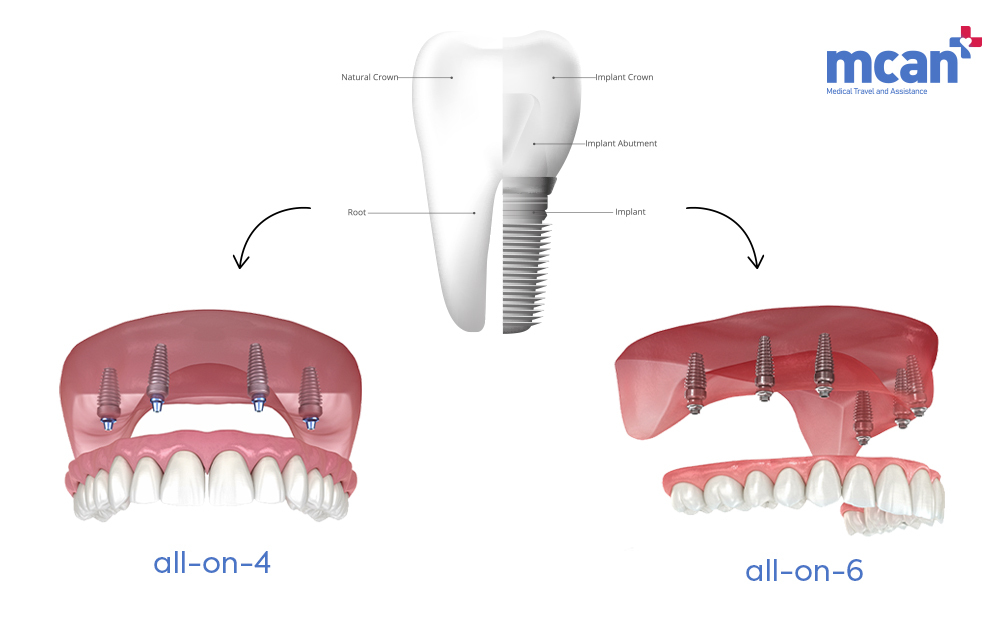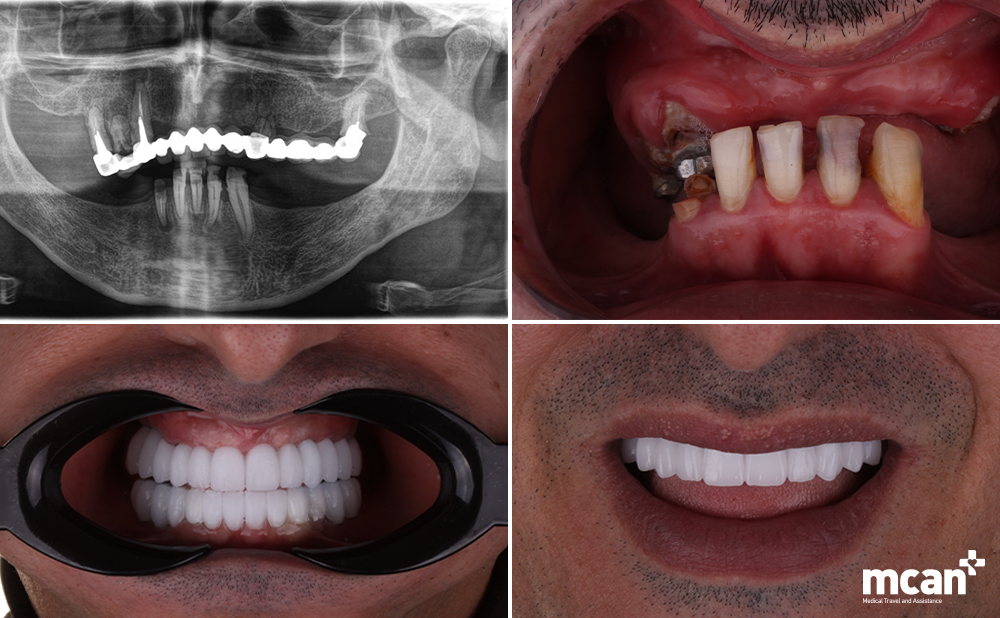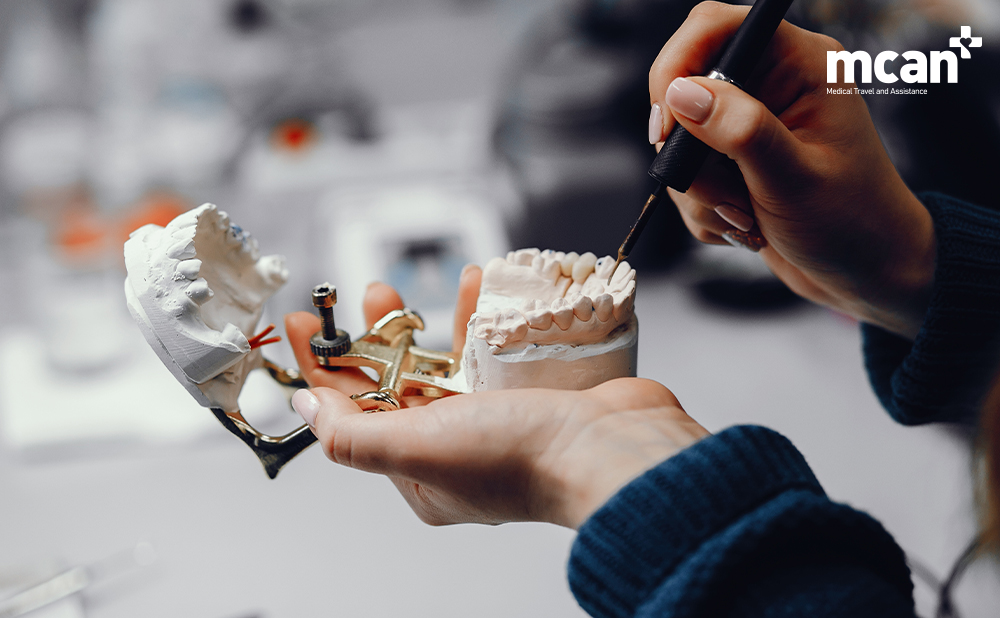
Tooth loss in the upper or lower arch can significantly affect not just your smile, but your ability to chew, speak, and feel confident in everyday life. Thankfully, advancements in implant dentistry now offer long-term, fixed solutions that go beyond traditional dentures with All-on-4 and All-on-6 dental implants.
Both systems restore a full arch of teeth using strategically placed implants and a fixed bridge, providing patients with a permanent, stable alternative to removable prosthetics. But how do they differ? And which one is right for your oral health, budget, and long-term goals?
In this guide, we’ll explore the key differences between All-on-4 and All-on-6, compare their pros and cons, and help you understand which solution best fits your individual needs. Whether you’re just beginning your smile restoration journey or weighing your implant options, this article will provide the clarity you need to make a confident choice.
What Are All-on-4 and All-on-6 Dental Implants?

When it comes to full-arch restorations, All-on-4 and All-on-6 dental implants are two of the most advanced, long-lasting solutions available. Both approaches are designed to replace an entire row of missing teeth with a fixed prosthesis supported by dental implants but the number and positioning of these implants make a key difference.
Let’s take a closer look at each method individually before comparing them side by side.
All-on-4 Dental Implants: Fewer Implants, Big Impact
All-on-4 implants involve the placement of four titanium implants in the jaw to anchor a full-arch prosthesis. The front two implants are placed vertically, while the back two are strategically angled to maximize bone contact and avoid the need for bone grafting in many cases.
This technique was originally developed for patients with low bone density, offering a quicker, less invasive option with fewer implants. All-on-4 is often chosen for its shorter treatment time, reduced cost, and predictable results.
If you’re new to this treatment concept, our All-on-4 Dental Implants in Turkey: A Complete Guide provides a detailed overview of what to expect.
All-on-6 Dental Implants: Extra Support for Long-Term Stability
All-on-6 implants follow the same concept but with six implants supporting the full arch. With two additional implants, the force from biting and chewing is distributed more evenly across the jaw. This added support can improve overall durability and extend the lifespan of the prosthesis.
This method is especially recommended for patients with adequate bone structure or higher bite force, and those who prefer a more robust, stable solution with increased long-term success potential.
All-on-4 vs. All-on-6: At a Glance
| Feature | All-on-4 | All-on-6 |
|---|---|---|
| Number of Implants | 4 | 6 |
| Bone Requirement | Lower, ideal for those with bone loss | Higher, requires more bone volume |
| Stability & Support | Very stable, but limited distribution | Enhanced support and bite distribution |
| Chewing Efficiency | Suitable for normal function | Better suited for higher bite pressure |
| Cost | Generally more affordable | Slightly more expensive due to extras |
| Treatment Time | Often quicker with fewer implants | May involve a longer procedure |
| Ideal Candidate | Patients with bone loss or limited density | Patients with better bone quality and long-term needs |
Key Differences in Treatment Planning and Recovery
Although All-on-4 and All-on-6 share the goal of full-arch restoration, the treatment planning, surgical approach, and recovery experience can differ significantly. These differences often influence which solution is more appropriate based on your individual oral health, bone density, and lifestyle.
Treatment Planning
Both treatments begin with a comprehensive dental assessment, including digital imaging (such as CBCT scans), oral exams, and medical history evaluation. However, the extent of planning can vary:
All-on-4:
- Typically involves less invasive diagnostics.
- Due to the angled placement of the back implants, it often avoids bone grafting, even in cases with moderate bone loss.
- Often selected when time and budget are limiting factors.
All-on-6:
- Requires more thorough planning to ensure sufficient bone support for six implants.
- Patients may need bone grafting or sinus lifting if the volume is insufficient.
- Focused on long-term biomechanical stability, especially for younger patients or those with strong bite forces.
If you’re considering this approach, our blog on What to Expect After All-on-6 Dental Implants: Recovery and Long-Term Care explains about post-operative healing timelines, hygiene tips, and the kind of maintenance needed for lasting results.
Recovery Process
While both techniques offer fixed, same-day teeth in many cases, recovery timelines can vary slightly based on the number of implants and surgical complexity.
| Factor | All-on-4 | All-on-6 |
|---|---|---|
| Surgical Invasiveness | Less invasive due to fewer implants | Slightly more invasive with 2 extra implants |
| Initial Healing | 7–10 days for soft tissue recovery | 10–14 days due to broader surgical area |
| Osseointegration | 3–6 months (typical range) | 4–6 months (may vary based on bone grafts) |
| Temporary Prosthesis | Often fitted same day | Same-day or next-day placement depending on case |
| Final Prosthesis | After healing and integration | After healing and integration |
Who Is a Better Candidate for Each Treatment?

Choosing between All-on-4 and All-on-6 dental implants is about what your oral health, bone structure, and long-term goals require.
All-on-4 might be ideal if you:
- Have moderate bone loss in the jaw and want to avoid grafting.
- Need a quicker solution with a shorter recovery time.
- Are seeking a more cost-effective full-arch restoration.
- Prefer minimal surgical intervention.
- Have existing health concerns that make extended surgery riskier.
- Want a reliable but streamlined alternative to dentures.
All-on-6 might be ideal if you:
- Have good bone density or are willing to undergo bone grafting.
- Want the highest level of bite support and prosthesis stability.
- Are younger or middle-aged and aiming for a long-term solution that can handle stronger bite forces.
- Have a history of bruxism (teeth grinding) or need more implant support.
- Are seeking a more permanent, fixed smile restoration.
Cost Comparison and Long-Term Value: All-on-4 vs. All-on-6
When evaluating full-arch dental implants, cost is often a deciding factor. Let’s break down how All-on-4 and All-on-6 compare financially and in terms of value over time.
Key Financial Considerations
| Factor | All-on-4 | All-on-6 |
|---|---|---|
| Initial Cost | Lower overall cost due to fewer implants and shorter surgical time | Higher upfront cost due to more implants and longer procedure |
| Surgical Complexity | Less invasive, fewer implants, often no bone grafting | May require bone grafting or additional planning |
| Prosthetic Support | Reliable for moderate function and aesthetics | Greater stability and better load distribution for long-term use |
| Longevity & Durability | Excellent with proper care, but fewer implants may mean more stress on each | Superior support and longevity, especially for patients with strong bites |
| Maintenance & Adjustments | May require adjustments sooner due to higher load per implant | Generally less maintenance due to better stress distribution |
| Overall Value | Cost-effective for appropriate candidates | Higher investment, but potentially fewer long-term complications |
Longevity, Functionality, and Comfort in Daily Life

When choosing between All-on-4 and All-on-6, it’s important to consider how each option performs not just in the clinic, but in your everyday life. Your ability to eat comfortably, speak confidently, and maintain long-term oral health all hinge on how well your full-arch solution integrates with your lifestyle.
Long-Term Durability
- All-on-4 implants provide reliable support for the prosthetic arch, but because only four implants bear the full load, they are under more stress. With proper hygiene and regular checkups, All-on-4 systems can last 10–15 years or more, though occasional adjustments or replacements may be needed over time.
- All-on-6, on the other hand, distributes pressure more evenly across six implants, which often results in better long-term outcomes and fewer complications. The added support reduces the risk of prosthetic failure and extends the system’s lifespan which is often 15–20 years or longer with consistent care.
Daily Functionality and Comfort
- Biting and Chewing Power: All-on-6 generally provides stronger biting efficiency due to additional implants, which improves comfort when chewing tougher foods. All-on-4 may be slightly limited in this aspect, especially for patients with strong bite force.
- Speech and Stability: Both options improve speech clarity and facial aesthetics. However, the increased implant support with All-on-6 can offer a more natural feel and enhanced confidence when talking or laughing.
- Gum and Bone Support: With six implants, bone preservation and soft tissue support tend to be superior, which is particularly helpful in preventing facial collapse and maintaining oral health over time.
Ease of Maintenance
Both systems are designed for low-maintenance routines:
- Brush and floss daily with tools recommended by your dentist (e.g., water flossers or interdental brushes).
- Schedule regular dental cleanings and annual reviews of implant health.
- In All-on-6 systems, due to improved load distribution, components may stay in better condition for longer and may require fewer adjustments or repairs.
Living with All-on-4 or All-on-6: What to Expect Beyond the Operation
After the dental chair and initial healing phase, your implants become part of your everyday life. While both All-on-4 and All-on-6 are designed to restore your smile, the way they support your lifestyle, comfort, and oral health over time can differ in meaningful ways.
Everyday Function and Comfort
With All-on-4, the reduced number of implants still provides strong support for eating and speaking. But with only four anchor points, the load on each implant can be more concentrated So, it may lead to a slightly more delicate experience with tougher foods or heavier bite forces. That said, for many patients, it delivers all the functionality they need with fewer components to manage.
All-on-6, with two extra implants, creates a more even force distribution. This added stability doesn’t just enhance chewing power, it also gives patients more freedom and confidence in daily routines. It can also feel more natural over time, especially for those who’ve previously worn dentures or had multiple missing teeth.
Long-Term Wear and Maintenance
The lifespan of either system depends on daily care, but All-on-6 may offer an edge in longevity. With less strain on each implant, the bridge is more likely to stay intact longer, reducing the need for repairs or replacements. All-on-4 remains a strong contender, especially when maintained well but its simpler structure may mean earlier interventions in some cases.
Oral Health Preservation
Bone preservation is a major benefit of both options, yet All-on-6 typically offers enhanced jaw support. More implants mean more surface area in contact with bone, which can better combat the resorption that often follows tooth loss. This subtle difference can have a visible impact on facial structure over the years.
Why Choose MCAN Dental for All-on-4 or All-on-6 Implants in Turkey?

When it comes to full-arch dental implants, precision, expertise, and trust are everything. Whether you’re leaning toward the streamlined All-on-4 approach or the enhanced support of All-on-6, your choice of clinic can determine the success, comfort, and longevity of your new smile.
At MCAN Dental in Istanbul, we specialize in advanced implantology tailored for international patients. Our team of experienced implant dentists uses state-of-the-art diagnostic tools, including CBCT scanning and 3D-guided surgery, to ensure each implant is placed with accuracy and long-term stability in mind.
Why MCAN Dental stands out for full-arch implant solutions:
- Expert Implantologists: Skilled in both All-on-4 and All-on-6 techniques, with thousands of successful cases for patients from around the world.
- Advanced Surgical Planning: Every treatment is backed by digital mapping and precise surgical guides for predictable results.
- Individualized Recommendations: We don’t believe in one-size-fits-all. Your treatment plan is built around your bone structure, bite force, and long-term goals.
- Full-Service Experience: From airport transfers and accommodation to recovery follow-ups and 12-month remote support, we take care of everything.
- Transparent Pricing: All-inclusive packages with no hidden costs
Whether you’re restoring your smile after years of tooth loss or upgrading from removable dentures, MCAN Dental offers a smooth, safe, and expertly managed path to a new you.
